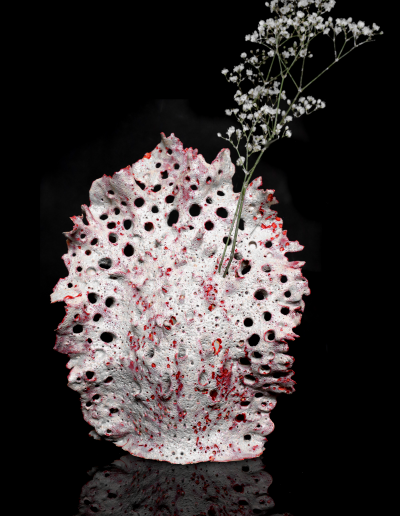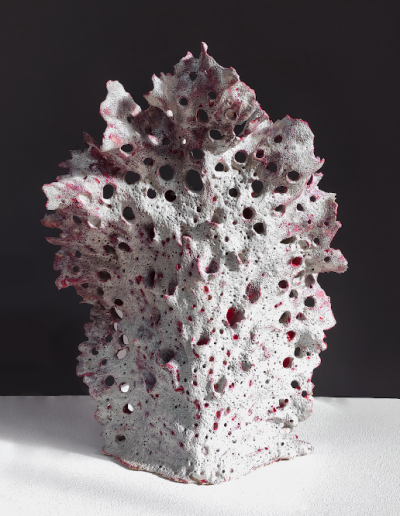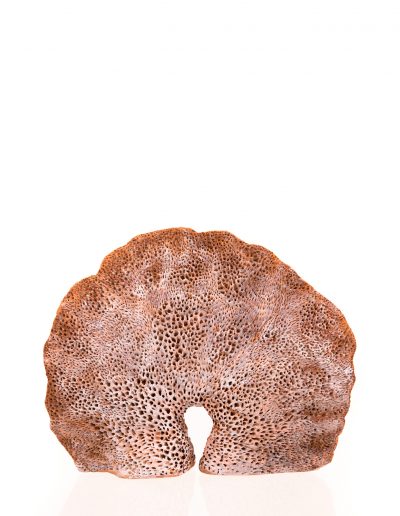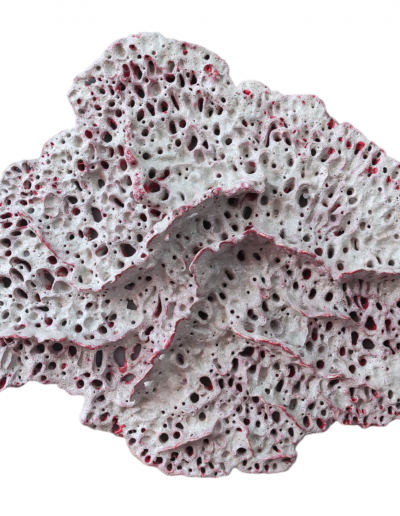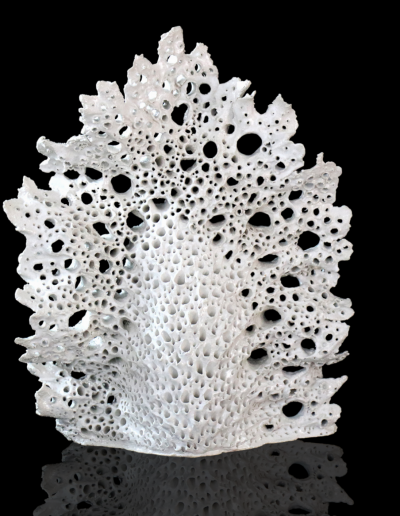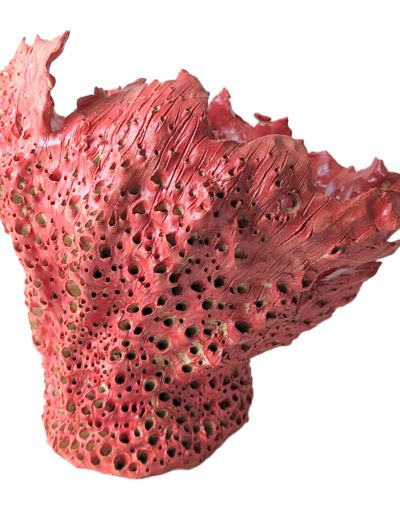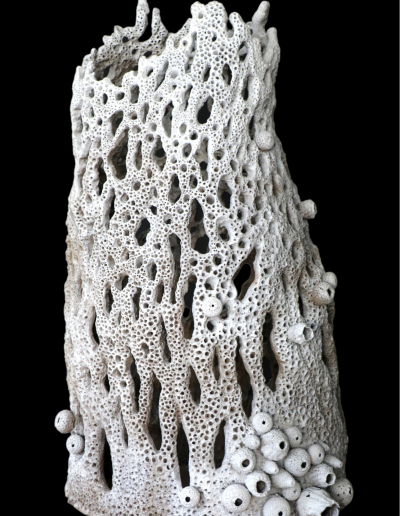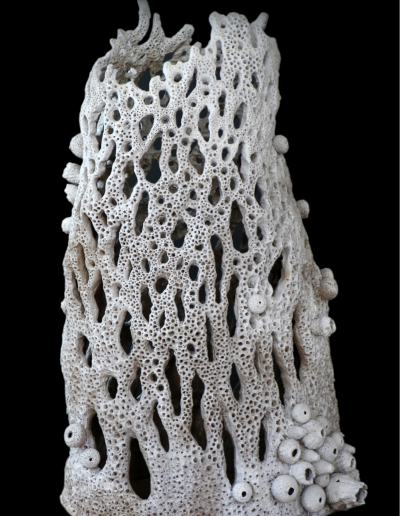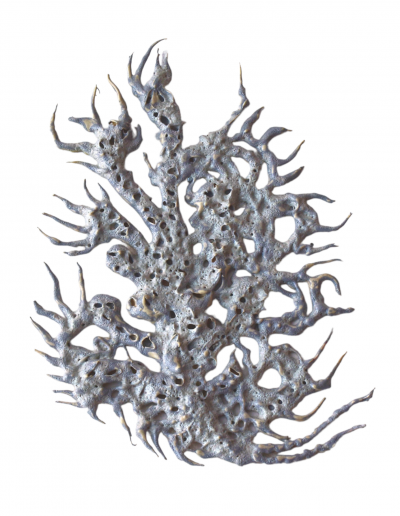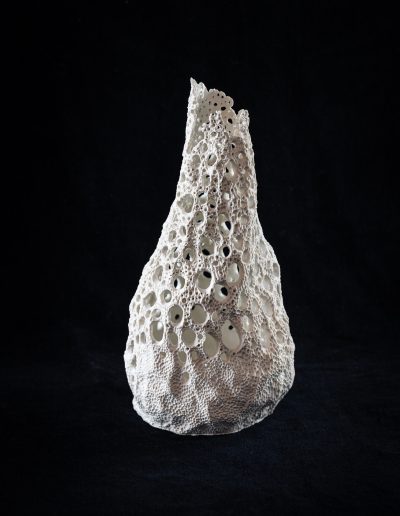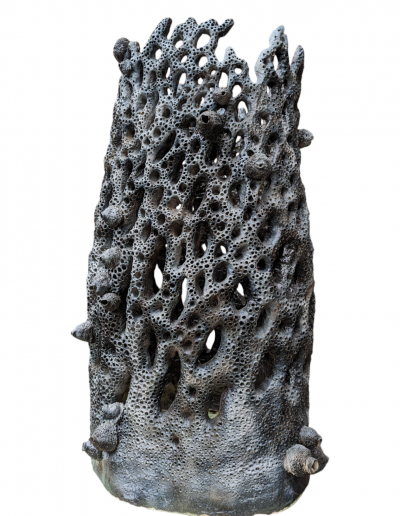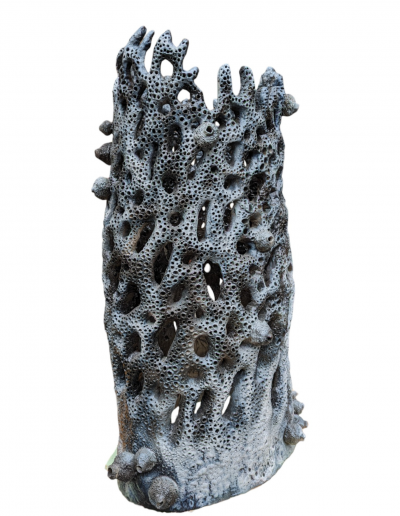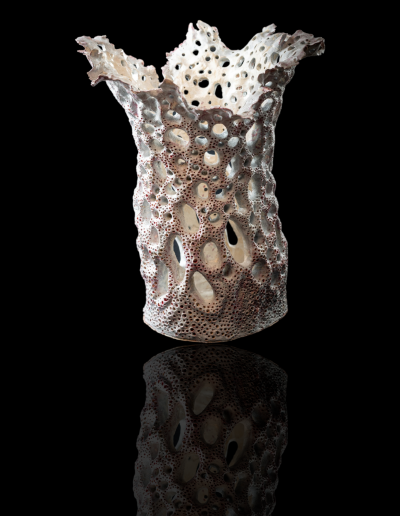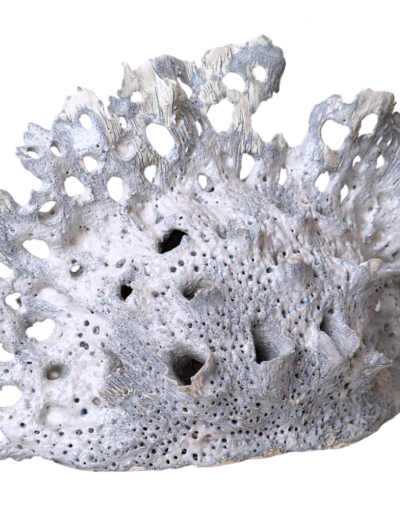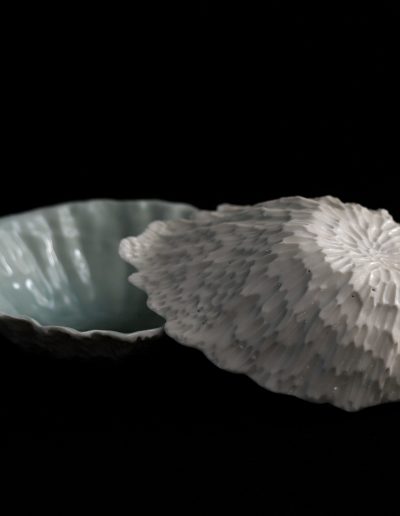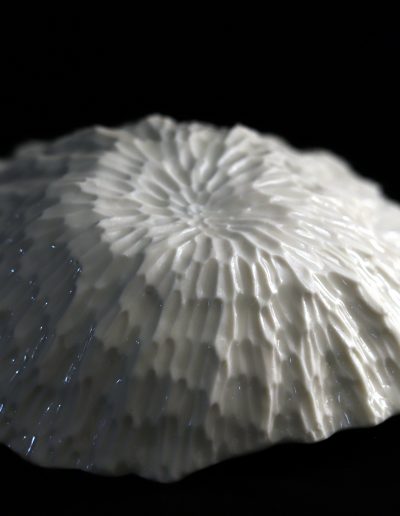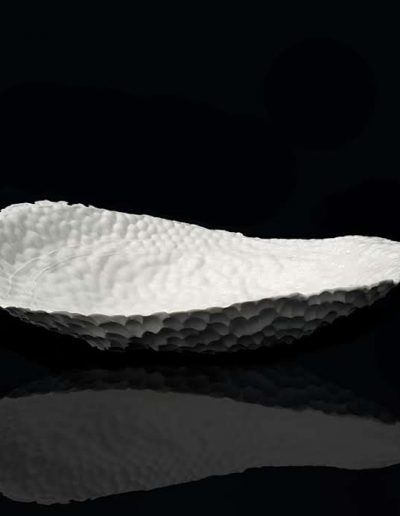Felicithas Arndt
WORKS
ARTIST
Felicithas Arndt
Translation of the speech by Dr Martina Wehlte on the occasion of the vernissage on 05.03.2023 at Kunstverein Bruchsal
“Felicithas Arndt is an artist whose work focusses on ceramics. After studying Southeast Asian Studies and Sinology in Frankfurt, she took the decisive step into art in 2014 and enrolled at the Hochschule für Gestaltung in her home town of Offenbach. With a DAAD scholarship, she spent a semester abroad in China at the Sichuan Fine Arts Institute in 2018 and her delicate drawings seem to be somewhat inspired by her impressions of Asia.”
“This was followed in 2021 by an internship in porcelain design at the Höchster Porzellan Manufaktur Frankfurt, where she has been working as a freelance artist ever since. In 2022, she won one of ten places in the X Keramika project organised by Majolika Manufaktur Karlsruhe, which includes a quarter-year artist residency, an exhibition and a scholarship from the state of Baden-Württemberg, Majolika Karlsruhe and the Egerland Foundation.
With regard to Felicithas Arndt’s work, it is interesting to note how Majolika Manufaktur defines the X Keramika project, which was launched in May 2022, as “an experimental, collaborative laboratory positioned between the material and immaterial aspects of media art and ceramic art”.
As a platform for interaction described in this way, the time-honoured institution, which has long struggled to survive, seeks to give itself the profile of an innovative art institution. The X stands for the cross-connection between tradition and innovation, which materialises in the interaction between ceramic material and media technology. How should we visualise this alliance?
Well, for example, as a combination of different production methods, namely working by hand in clay and ceramic printing from the Majolika 3D Lab. The large sculpture from the Madrepora series of works on the ground floor was created in this way last year, as a combination of a hand-modelled hollow body and attached spheres from the 3D printer. Like most of Felicitha Arndt’s other works, this one is associated with a world at the interface between the animal and plant kingdoms, a world of quiet growth and gentle movement. The stone-like outer skin appears fragile and could be a tubular underwater animal stuck to the ground, feeding on the particles flowing through its habitat.
The name Madrepora for the series of works created in 2022 is that of a deep-sea stony coral that first became known through cable-guided underwater vehicles. The deep-sea animals are known to have existed 30 million years ago and their current cold-water reefs may have formed up to 200,000 years ago. Their calcareous skeletons, typical of corals, branch out like ferns or form ring-like or tubular shapes. They are often white or grey, but also pale salmon red or greenish. The artist takes up their appearance in objects that are glazed in silvery grey and occasionally interspersed with red.
Fluctuation is the title of a series begun in winter 2022 in stoneware, which – unlike earthenware – is a weather-resistant material that is also suitable for outdoor use. The honeycomb-like segments then provide a home for insects, worms and other creatures and, logically, a relief of this kind is attached to a tree in front of Damianstor as a place to live. Felicithas Arndt thus develops the idea of majolica further for her X Keramika project. If the intention of the project is: “The tools and materials of the lab are part of a dynamically developing ecosystem that enables new connections between technologies and materials to be found in space that would not have been possible in a different context”, then the term ‘ecosystem’ is a keyword to describe Felicithas Arndt’s design principles and her approach of bringing art and nature into direct interaction.
Let’s go back to looking at the work and find an analogy to the concept in Karlsruhe just quoted: who didn’t feel reminded of corals and underwater sponges when looking at the exhibited works? These sessile animals absorb water through small pores, feeding on its particles by filtration and swirling them into the interior of their gastral cavity. They do not form organs, have no muscle cells, no sensory cells and no neurones, but can perform many of the functions of these cell types. Isn’t the uniformity of their structure and the complexity of their mysterious interactions comparable to digital media? Are the blueprints of the digital world, its structures and systems, which create astonishing functions from combinations of a manageable number of elements, not similar to the power of the cell types mentioned?
Felicitha Arndt’s aesthetic objects and reliefs are artistic creations analogous to nature, without imitating it. Her rhythmically flowing forms are carefully worked out, the immanent movement, the surface reliefs of capillaries and narrow webs are created in the course of the work process without any prior design. The entire appearance alternates between compact and permeable and is characterised by the interplay of inside and outside. Fluctuation and Pieces of Nature are fitting titles for these works of different sizes, which are usually fired twice and either left natural or glazed to give them a nuanced colour. As with the sponge animals, the delicacy of the walls, their simultaneous stability and the receptivity of the entire body is a labyrinthine marvel that draws our gaze into the unfathomable interior, into a hidden centre. The horny egg capsules of the catshark were also the inspiration for some of the objects. The capsules are about 6 cm long, translucent light brown in colour and have curled threads at the corners. They are fruit capsules of nascent life and the goblet-like opening standing objects or the flat reliefs spreading across the wall also seem to be filled with life.
Felicithas Arndt is interested in primitive natural systems, meandering forms and symbiotic communities. Fungi with their widely ramified mycelia, algae, lichens or even sponges are robust survival artists whose principles could be adopted by humans, just as they have often taken nature as a model for technical developments. In her work, the ceramist thus also offers a constructive approach in the age of the Anthropocene, in which the possessive, destructive character of the human species is usually focussed on. Her stoneware works are heavily hardened by double firing, meaning they hardly absorb any water and are therefore also suitable for outdoor use.
The clay capillaries provide a home for earthworms or beetles in the garden, are mossed over and thus give something back to nature that was previously taken from it as clay, so that nature ultimately regains the upper hand. Incidentally, this form of co-operation is also used on a large scale as a kind of renaturation when 3D coral reefs are installed in the sea so that natural corals can colonise them again.
Felicithas Arndt is aware of this and her artistic approach should be seen in the context of a holistic way of thinking that recognises and acknowledges the interdependencies in nature, the beneficial cooperation and the longevity achieved by conserving resources.
The large ink drawings on tissue paper fit harmoniously into this cosmos. The blue-green fish, a dragon-like fantasy creature, the mysterious black bird whose body flows into abstract dissolution, reveal influences from Asian motifs and drawing art. Fragile-looking porcelain works in bright white and collagraphs complete the spectrum of this exhibition. A collagraph is a print of material – in this case clay – on paper, cardboard or another solid surface. The sheets on display create an optical effect reminiscent of the falling and spreading of a slightly coloured drop of water on a calm surface. Also unusual are the sediments presented behind glass, compositions of wafer-thin, paper-like porcelain sheets, coloured white and blue. They are fired to over 1200 degrees and then dried for one to two weeks. Felicithas Arndt’s oeuvre to date is characterised by a love of experimentation, a wealth of ideas, creative energy and solid craftsmanship. She is breaking new ground and one can assume that this has required some patience.
In any case, all the effort is worth it, because the young artist shows aesthetically and technically impressive works and certainly has a promising development ahead of her. In her still short career, she has taken part in numerous group exhibitions and now has her first solo exhibition in Bruchsal. From 15 May, she will be represented at the International Ceramics Triennial in Slovenia and from 1 July in Faenza, Italy, where she has been nominated for the Grand International Ceramics Prize. That alone is remarkable and we wish her every success at both forums.”
BIOGRAPHY
1992
Born in Offenbach / Main
2012-2013
Sinology and Southeast Asian Studies at Goethe Universität Frankfurt / Main
Seit 2014
Fine Art studies at HfG Offenbach
Focus on ceramics, graphic prints and painting by Prof. Klaus Hesse, Merja Herzog-Hellstén and Volker Steinbacher
2017
Excursion and exhibition with Prof Klaus Hesse in the porcelain capital Jingdezhen/China
2019
Senckenberg design competition of Senckenbergpreisskulptur, organised by Senckenberg Gesellschaft für Naturforschung and Förderverein Senckenberg, nomination for 3rd place
Rundgang Hochschule für Gestaltung Offenbach, nomination for the Rundgandpreis
Since 2021
Work as a freelance artist
Commissions for the Porzellan-Manufaktur in Höchst, Frankfurt / Main and the Majolika Manufaktur Karlsruhe
2021
Rundgang Hochschule für Gestaltung Offenbach, nomination for the Rundgangpreis with work group “Sediments”
2022
Selected for Ambiente Talents and Ambiente Trends 22+
Winner of X-Keramika competition, artist residency, exhibition at Galerie Majolika and scholarship from the state of Baden-Württemberg
Series of works “Sediment” and “Fluktuation” selected for Handwerksform Hannover “Young Professionals”
2023
Finalist in the renowned international art ceramics competition “Faenza Prize”, Italy
Finalist in the “UNICUM” competition, international ceramics triennial, Slovenia
Selected for Ambiente Talents and Ambiente Trends 23+
EXHIBITIONS
(S) = Solo Exhibition / Einzelausstellung
(G) = Group Exhibition / Gruppenausstellung
SOLO & GROUP EXHIBITIONS
2020er
2023
Special exhibition of ceramics, Discovery Art Fair, Frankfurt am Main
Kunstverein Bruchsal, solo exhibition “Keramik und Zeichnung” (S)
Ambiente Fair Frankfurt, Talents
2022
Majolika Karlsruhe, artist residency scholarship from the state of Baden-Württemberg, “X-Keramika” project
2021
Villa Metzler M21, Kunstgewerbeverein e.V. Frankfurt (G)
Anniversary exhibition 250 years Höchster Porzellan Manufaktur Frankfurt
Collective Magma Maria, sales exhibition Frankfurter Kunst Vertrieb, Frankfurter Kunstverein
“Rundgang” annual exhibition, Offenbach University of Art and Design, nomination for the Rundgangpreis for the group of works “Sediments”
“HeimSpiel”, Haus der Stadtgeschichte Offenbach (G)
2020
Group exhibition & design of the image window and the porcelain collection in Höchster Porzellan Manufaktur, cooperation between Labor Kunst HfG and Höchster Porzellan Manufaktur Frankfurt
2010er
2019
Villa Metzler M19, Keramik und Glas (G)
»What’s behind the wall« Gruppenausstellung bei der »International Paper Art Biennale Shanghai 2019«, Fengxian Museum, Shanghai, China (G)
Schloß Fasanerie Fulda Feinmarkt „Entremets“ (G)
Sculpture competition Skulpturenpark Mörfelden-Walldorf (G)
Rundgang Hochschule für Gestaltung Offenbach, nomination for the Rundgangpreis (G)
„No STRG Z“ Verein für Original-Radierung München e.V. (G)
Senckenbergpreis 3rd place at sculpture competition from Senckenberggesellschaft für Naturforschung, exhibition Senckenberg Museum Frankfurt / Main
2017
Schloss Fasanerie „The New Blue“ (G)
Rundgang Hochschule für Gestaltung Offenbach (G)
„The New Blue – Porcelain instead of Paper“ by Prof. Klaus Hesse, Jingdezhen Ceramic Institute, Jingdezhen, China (G)

